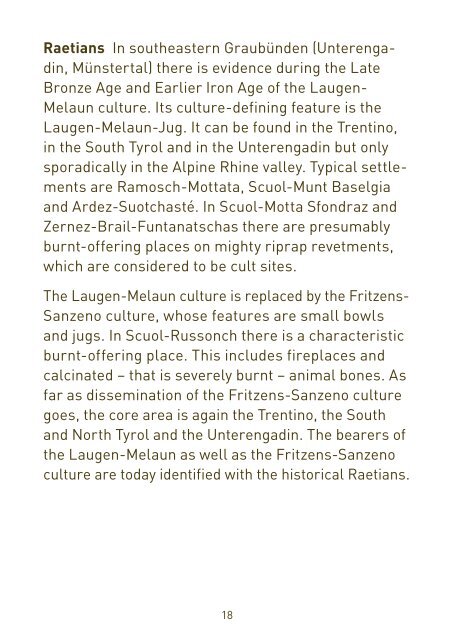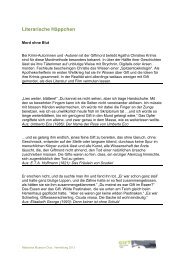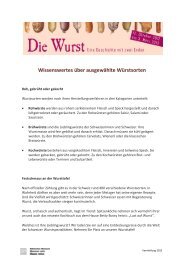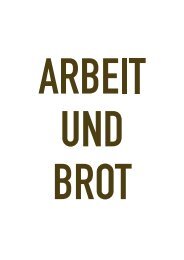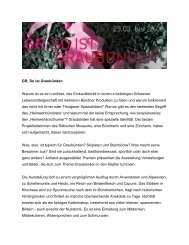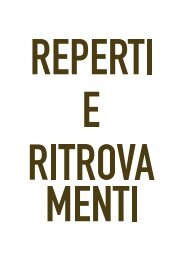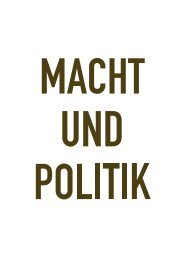Finds and Findings - Raetisches Museum - Kanton Graubünden
Finds and Findings - Raetisches Museum - Kanton Graubünden
Finds and Findings - Raetisches Museum - Kanton Graubünden
Create successful ePaper yourself
Turn your PDF publications into a flip-book with our unique Google optimized e-Paper software.
Raetians In southeastern <strong>Graubünden</strong> (Unterengadin,<br />
Münstertal) there is evidence during the Late<br />
Bronze Age <strong>and</strong> Earlier Iron Age of the Laugen-<br />
Melaun culture. Its culture-defining feature is the<br />
Laugen-Melaun-Jug. It can be found in the Trentino,<br />
in the South Tyrol <strong>and</strong> in the Unterengadin but only<br />
sporadically in the Alpine Rhine valley. Typical settlements<br />
are Ramosch-Mottata, Scuol-Munt Baselgia<br />
<strong>and</strong> Ardez-Suotchasté. In Scuol-Motta Sfondraz <strong>and</strong><br />
Zernez-Brail-Funtanatschas there are presumably<br />
burnt-offering places on mighty riprap revetments,<br />
which are considered to be cult sites.<br />
The Laugen-Melaun culture is replaced by the Fritzens-<br />
Sanzeno culture, whose features are small bowls<br />
<strong>and</strong> jugs. In Scuol-Russonch there is a characteristic<br />
burnt-offering place. This includes fireplaces <strong>and</strong><br />
calcinated – that is severely burnt – animal bones. As<br />
far as dissemination of the Fritzens-Sanzeno culture<br />
goes, the core area is again the Trentino, the South<br />
<strong>and</strong> North Tyrol <strong>and</strong> the Unterengadin. The bearers of<br />
the Laugen-Melaun as well as the Fritzens-Sanzeno<br />
culture are today identified with the historical Raetians.<br />
Celto-Raetians <strong>and</strong> Celts As of the Late Bronze Age<br />
the urn field culture becomes visible in north <strong>and</strong><br />
middle <strong>Graubünden</strong> (Chur-Karlihof, Vella-Pleif, etc.). It<br />
clearly advances from the north. In north <strong>Graubünden</strong><br />
it is overlaid by an element of the Laugen-Melaun<br />
culture (Celto-Raetian mixed culture). As of the Earlier<br />
Iron Age marked influences of the Hallstatt culture<br />
become apparent (Felsberg-Felixwingert, painted<br />
pottery from Tamins). In the Later Iron Age with the<br />
Tamins <strong>and</strong> Schneller pottery (Alpine Rhine Valley<br />
groups), the grooved pottery (Kammstrich-Keramik)<br />
<strong>and</strong> later the graphite-clay pottery the Celtic northern<br />
influence remains clearly visible.<br />
The Laugen-Melaun elements of the Late Bronze Age,<br />
which reached northern <strong>Graubünden</strong> over the Vorarlberg,<br />
still recall the Raetian culture. Undoubtedly<br />
the Celtic element had been predominant since the<br />
Iron Age. For northern <strong>Graubünden</strong> corresponding<br />
settlement-remains exist (Chur-Welschdörfli, Fläsch,<br />
Lantsch/Lenz, Suraua, Trun-Darvella, etc.). The<br />
same is true of grave finds (Tamins urn grave field,<br />
Trun-Darvella, etc.). The Raetian element completely<br />
disappears at this time.<br />
18 19


